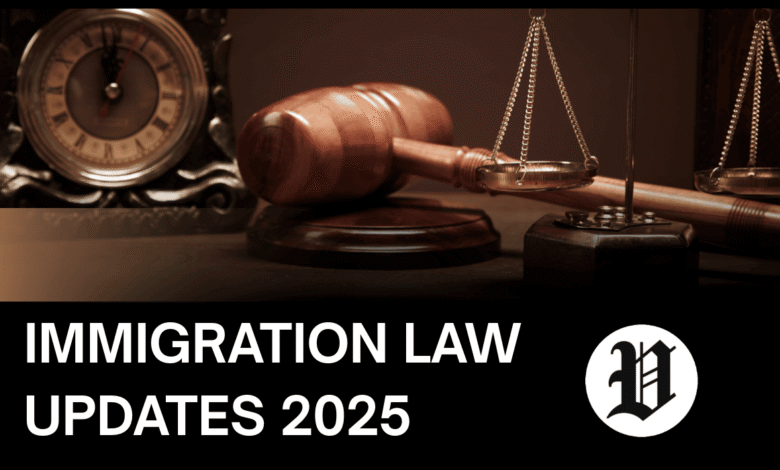Immigration Law Updates 2025: What’s Changing and Why It Matters

Imagine waking up to news that a single Supreme Court decision has given ICE agents the green light to patrol neighborhoods and pull people over based on little more than a hunch about their background. That’s the reality hitting immigrants in cities like Los Angeles right now. As we step into the heart of these shifts, it’s evident that 2025 is reshaping the immigration landscape in ways that touch everyone from families seeking refuge to businesses hunting for talent.
Introduction: Why 2025 Is a Turning Point for Immigration Law
This year stands out because of a surge in enforcement-focused policies under the returning Trump administration. We’re seeing executive orders and new laws that tighten borders, expand detentions, and limit relief options. It’s all about prioritizing security, but it leaves many wondering about the human cost.
Bills like the One Big Beautiful Bill Act are pumping massive funds into walls, tech for tracking, and more detention space. For lawyers and immigrants, these immigration law updates mean navigating a tougher system where one wrong step could lead to big consequences.
Supreme Court Immigration Ruling: ICE Patrols and Profiling Case
In a key case, the Supreme Court sided with the government, allowing ICE to restart roving patrols in places like Los Angeles. Agents can now stop folks if they suspect something based on appearance, job, or even the language spoken. Critics call it a door wide open to racial profiling, and it’s already making communities tense.
Before this, lower courts had put a stop to it, saying it violated rights. Now, with the ruling in place, enforcement is ramping up, targeting workers and public spots. People are staying indoors more, afraid of random checks that could end in deportation.
Citizenship Test Updates: New Essay and Neighbor Interview Rule
Getting citizenship just got harder with the 2025 updates to the test. USCIS is adding an essay section to really dig into your understanding of American history and values. It’s not just rote memorization anymore; they want to see you explain concepts in your own words.
On top of that, they’re bringing back interviews with neighbors or coworkers to check on your character. These were on hold for a while due to the pandemic, but now they’re selective, popping up when something raises a flag. Applicants need to be ready for this extra layer, which could slow things down if references don’t line up perfectly.
Mandatory Detention Expansion: Bond Hearings Cut Off
Detention rules have toughened up, with more people stuck in facilities without a shot at bond. If you crossed the border without papers, chances are you’ll stay locked up through your whole case. Immigration judges used to have more say in releases, but that’s changing fast.
Facilities are expanding to hold tens of thousands more, and reports of overcrowding are already surfacing. For families, this means separations that drag on, raising concerns about health and fairness in the process.
Asylum Restrictions: Higher Standard for Domestic and Gang Violence Claims
Asylum seekers face steeper hurdles now, especially if their claims involve domestic abuse or gang threats. The bar is higher—you have to show not just the danger, but that your home government can’t or won’t help. It’s a shift from broader protections we saw before.
This hits hard for folks fleeing violence in places like Central America. Denials are climbing, and many end up without options, slipping into the shadows to avoid going back to peril.
USCIS Becoming Law Enforcement: New Powers
USCIS isn’t just handling paperwork anymore; they’ve stepped into enforcement territory. Their agents can carry guns, make arrests, and search places if they sniff out fraud. It’s a big change from their old role focused on benefits like visas and green cards.
This means more site visits and investigations during applications. If you’re applying, double-check everything—mistakes could trigger a deeper probe that complicates your case.
Visa Backlogs and Employment-Based Delays
Those waiting for work visas are in for longer hauls, with backlogs stretching years for categories like EB-2. Demand is sky-high, but the yearly caps haven’t budged much, causing delays even for applicants from less crowded countries.
Businesses feel the pinch, struggling to keep skilled workers while extensions pile up. There’s talk in new bills about capping waits at a decade, but so far, it’s more words than action.
Major Legislative and Executive Actions
Right out of the gate, an executive order challenged birthright citizenship, saying kids born here to non-citizen parents don’t automatically get it. It’s based on a narrow read of the Constitution and has lawsuits flying. A fresh travel ban blocks folks from certain countries, citing security.
The Laken Riley Act ramps up detentions for immigrants tied to crimes like burglary, aiming to deport them quicker. Then there’s the Dignity Act, which promises some relief on backlogs and asylum, but it’s stuck in Congress. The One Big Beautiful Bill Act ties it all together with big bucks for biometrics, fees, and cutting aid programs.
Table: Quick View of Immigration Changes in 2025
| Area | Pre-2025 Status | 2025 Changes | Impact |
|---|---|---|---|
| Asylum Claims | Wider acceptance for personal violence | Stricter proof needed, narrower grounds | More rejections, hidden lives |
| Citizenship Test | Basic questions, limited checks | Essays added, neighbor talks back | Tougher path, longer waits |
| Detention | Bonds often available | Mandatory for many, no release options | Families split, centers strained |
| USCIS Powers | Paperwork only | Arrests and searches allowed | Applications riskier |
| Visa Backlogs | Long for some countries | Halts and extensions widespread | Talent drain for companies |
| Birthright Citizenship | Automatic for all born here | Challenged for non-citizen kids | Court battles, uncertain futures |
Closing Thoughts: Balancing Enforcement and RightsAt the end of the day, these updates lean heavy on enforcement, but they spark debates about where rights fit in. Stronger borders might feel safer to some, yet they disrupt lives and economies that thrive on diversity. If you’re reading this as a lawyer, immigrant, or employer, the real lesson is to act early—get advice from pros to safeguard your path in this new normal.
Informational FAQs
What is the biggest immigration law change in 2025?
I’d say the One Big Beautiful Bill Act takes the cake, dumping billions into security while slashing benefits and ramping up tracking.
How does the new citizenship test work?
It’s beefed up with an essay on civics and possible chats with your neighbors or work buddies to vouch for you.
Who is affected by the Supreme Court immigration ruling?
Mainly folks in high-immigrant areas like LA, where patrols could target based on looks or jobs, hitting workers hardest.
Can asylum seekers still apply under domestic violence or gang violence claims?
They can try, but the proof requirements are way tougher, so many get turned away.
What does the Laken Riley Act mean for immigrants?
It forces detention and fast deportations for those without status who commit certain crimes.
How long is the EB-2 visa backlog in 2025?
For spots like India, it’s over a decade; China isn’t far behind at five to seven years, and others are catching up.
Is birthright citizenship still valid in the U.S.?
It’s under fire from an executive order, but expect courts to weigh in on whether it sticks.
What is the One Big Beautiful Bill Act?
A massive funding push for borders, detentions, and tech, signed with fanfare but cutting help for immigrants.
How is USCIS different in 2025 compared to before?
They’ve gone from desk jobs to frontline enforcers, with power to arrest and investigate.
Where can immigrants get reliable help under the new rules?
Look to trusted nonprofits, legal aid groups, or DOJ-approved lawyers who know the ropes without pushing agendas.




